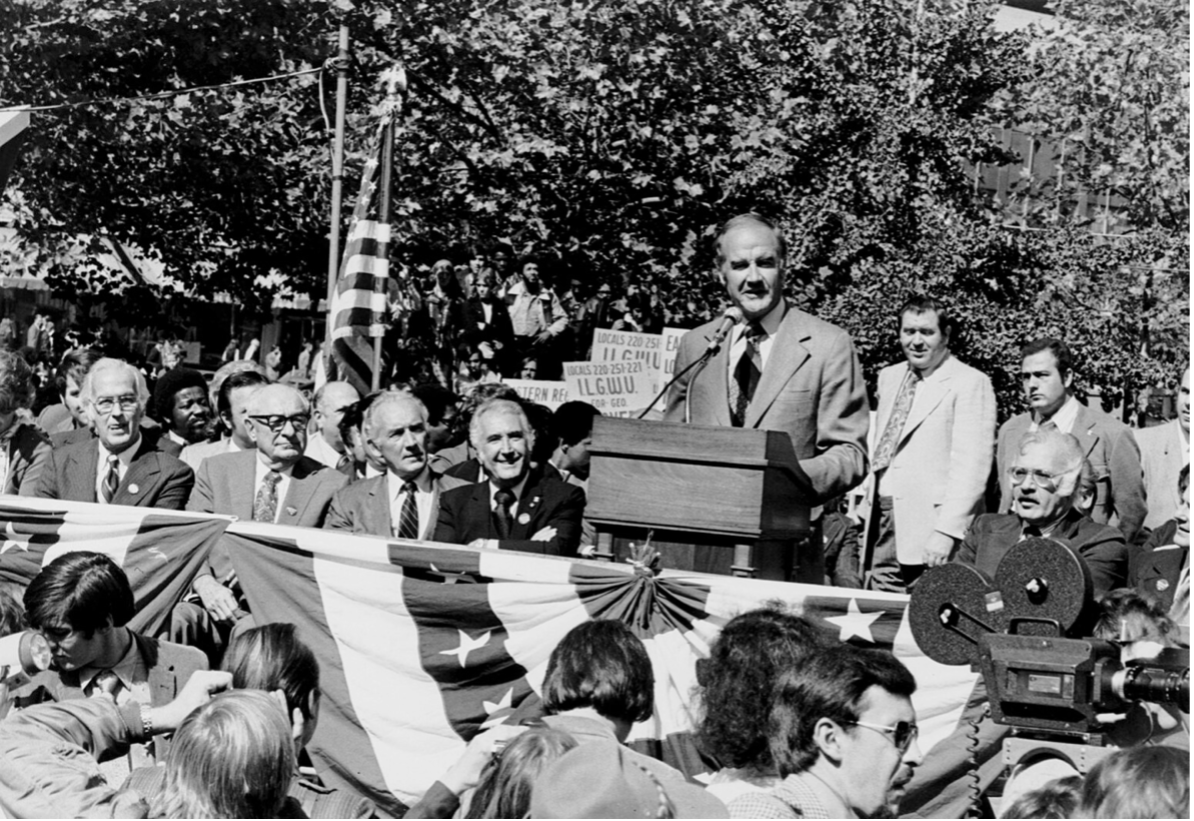Split Screen: Shirley Chisholm, cropped out of history
Photography can shape public perception of candidates. Continually showing a woman candidate alone makes it look as if she doesn't have support.
In 1972, U.S. Rep. Shirley Chisholm (D-N.Y.) made history as the first Black woman to run for a major party's presidential nomination. Her candidacy represented a pivotal moment in American politics. Close your eyes and picture her. Do you see her alone at a podium or commanding a crowd? If you've struggled to recall such images, there's a reason.
When analyzing the photographic record of Chisholm's groundbreaking campaign, I discovered three patterns of visual sexism that deserve our scrutiny: the persistent use of isolating close-ups, unflattering camera angles, and technical choices that failed to properly render her skin tone. This visual sexism didn't just document her candidacy—it also shaped how America perceived her campaign and the campaigns of women who came after her.
The Politics of Proximity: Close-ups Without Crowds
One of the most striking patterns in Chisholm's visual coverage was how frequently she was photographed in tight close-ups that removed the enthusiastic context of her campaign's energy and support. Her white male opponent, George McGovern, was routinely photographed with crowds of cheering supporters, but Chisholm was visually isolated.
Media scholar Jane Rhodes, who has extensively studied visual representations of Black political figures, notes that this isolation technique removes the subject from their political context and community of support, effectively diminishing their perceived political power. The contrast was striking. McGovern was shown as a leader with followers; Chisholm was framed as a solo figure, as a curiosity rather than a movement, a symbol rather than a winner.
Communication researcher Robert Entman's framing analysis quantified this difference: McGovern appeared with supporters in 78% of published campaign photographs, but Chisholm appeared alone in 64% of her coverage. This visual isolation didn't report the facts of Chisholm's campaign; it constructed a psychologically destructive and inaccurate narrative of her viability as a candidate.
This framing wasn't accidental. Kathleen Hall Jamieson's seminal work "Packaging the Presidency" documents how newspapers and television consistently chose tight shots of Chisholm's face while using wide shots for McGovern that captured the enthusiasm of his campaign events. When Chisholm spoke to packed rooms, photographers somehow managed to frame out the crowds.
As a cinematographer myself, I recognize that these are deliberate choices, not technical necessities. The decision to crop out Chisholm's supporters effectively cropped out her political viability.
Seven Minutes: If She Can’t See It, She Can’t Be It
Perhaps the most egregious example of visual erasure came during the 1972 Democratic National Convention. Despite being a legitimate candidate who had amassed delegates, Chisholm received just seven minutes of coverage during the entire convention broadcast. For comparison, McGovern received over two hours of airtime, while even non-candidate Senator Ted Kennedy was given a full 30 minutes for his speech. Most tellingly, Massachusetts Gov. John Volpe—a Republican who wasn't even running—received 15 minutes of coverage, more than twice what was allocated to Chisholm. This disparity wasn't merely a reflection of political standing; it was a construction of it, actively diminishing the first Black woman to seek a major party's nomination.
Communication scholar Shawn Parry-Giles has documented how this type of structured invisibility in political coverage creates a self-fulfilling prophecy: Limited visual presence leads viewers to perceive candidates as less viable, which justifies further limiting their coverage (Parry-Giles, 2002). Seven minutes wasn't just insufficient, or a mistake; it was actively delegitimizing.
This visual scarcity has profound consequences for our democracy. Communication researcher Johanna Dunaway has documented how the absence of images showing women as powerful, supported leaders creates a representation gap in our political imagination. When voters of all genders rarely see images of women commanding stages, drawing enthusiastic crowds, or speaking authoritatively, they develop unconscious biases about who belongs in leadership positions.
Even within those seven minutes, the visual framing matters. Jamieson’s and Paul Waldman's research in "The Press Effect" found that Chisholm was more frequently shown in reactive positions—listening or waiting—rather than in active leadership positions. These subtle visual cues communicate powerful messages about who belongs in positions of authority. The insidious sexism of this framing reinforces traditional gender roles: men speak, women listen; men lead, women follow. When viewers are repeatedly presented with images of female candidates passively receiving information rather than actively conveying their vision, it reinforces the unconscious bias that women are not leaders. Breaking this pattern requires conscious effort from those behind the camera.
Looking Down: The Politics of Camera Angles
When analyzing archival footage and photographs of Chisholm's campaign, another pattern emerges: she was consistently photographed from high angles that diminished her stature and authority. Camera angles aren't neutral—they construct power relationships between subject and viewer.
Analysis of campaign coverage by visual sociologist Bernadette Wegenstein found that Chisholm was photographed from high angles approximately 60% more frequently than McGovern. This wasn't merely aesthetic; it was political. McGovern was photographed from low angles that emphasized his height and authority, but Chisholm was shot from above, a visual technique that subtly undermined her power. In Chisholm’s campaign, we see a historical precedent for how women have been undermined through high angle framing.
Overexposing Racial Bias
Beyond framing and angles lies an even more fundamental issue: the technical calibration of photography itself. Media scholar Lorna Roth's groundbreaking work "Looking at Shirley, the Ultimate Norm" documents how photographic technology was literally designed around white skin. From light meters to film chemistry, the technical defaults of photography privileged white subjects.
For Chisholm, this meant that photographers and television cameras frequently rendered her with inaccurate exposure, either washing out her features or underexposing her image. Archival comparison of campaign coverage shows that McGovern was consistently photographed with proper exposure that accurately represented his features, but Chisholm often appeared with unnatural contrast or unflattering color rendering.
Proper exposure for skin tones isn't a technical challenge—it's a choice. When photographers consistently failed to adjust their settings for Chisholm's skin tone, their seemingly technical decision had political consequences.
The Visual Legacy
The visual politics that diminished Chisholm's campaign didn't end in 1972. They established patterns of representation that continue to shape how we visually frame women, especially women of color, in politics today. When female candidates, especially Black women, are shown in isolation rather than with supporters, photographed from unflattering angles, or improperly exposed, they're facing the same visual biases Chisholm confronted.
The seven minutes allocated to Chisholm at the 1972 convention didn't just limit her visibility then, it also limited our visual memory of her campaign now. Our collective imagery of presidential politics remains dominated by white men in front of cheering crowds, shot from heroic low angles, perfectly exposed. The visual erasure of Chisholm's campaign remains both a symptom and cause of political marginalization.
The damage extends beyond perception to real electoral outcomes. Political scientist Jennifer Lawless found that repeated exposure to images of women in positions of political authority significantly increases voters' willingness to support female candidates (Lawless, 2016). Without these visual references, voters—regardless of their conscious beliefs about gender equality—tend to default to “traditional” (read: white male) leadership models. Our democracy literally cannot see what it cannot imagine, and our imagination is shaped by the images we consume.
As we look at today's political coverage, we must ask: Whose supporters are being cropped out of the frame? Who is being shot from diminishing angles? Whose skin tone is being improperly exposed? The camera might seem objective, but the choices behind it never are.
Until next time, keep your eyes sharp and your lenses sharper.
Send examples of visual politics you've noticed to submit@contrariannews.org with the subject line SPLIT SCREEN.
*******
P.S.: I’ve started doing gender breakdowns of my research. For this article:
Total unique researchers: 10
Female researchers: 7 (70%)
Male researchers: 3 (30%)
Azza Cohen (she/her) is an award-winning documentary filmmaker who served as Vice President Kamala Harris's official videographer in the White House. She recently founded a production company with her wife, Kathleen, and is writing a book about visual sexism from a cinematographer's perspective. Uncover and address visual sexism alongside Azza every other week here on The Contrarian and on Instagram and Bluesky. Azza is, in fact, a big fan of The New Yorker, which bought and distributed her film “FLOAT!” in 2023.









"Despite being a legitimate candidate who had amassed delegates, Chisholm received just seven minutes of coverage during the entire convention broadcast."
This was a fraction of the screen time that her male counterparts got. And time in the spotlight is absolutely consequential. As a novelist, and y'all as movie goers, I know that "time" or space allotted to a character denotes their status in the story. The mains get the most face time; the lessers do not. It's simple math in the minds of readers or viewers. And so it goes with life.
And it works. At 62, I knew little about Chisholm until I saw the recent film "Shirley" (Of course it's called "Shirley"--whereas films about men use their last names). If you haven't seen it, check it out. And thanks, Azza, for another hurts-so-good analysis.
Excellent article! Thank you!